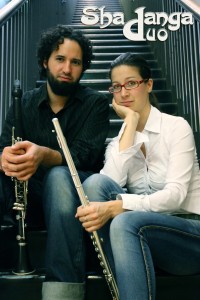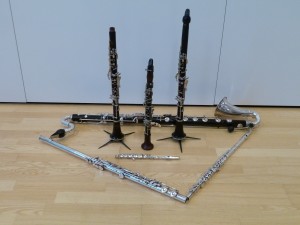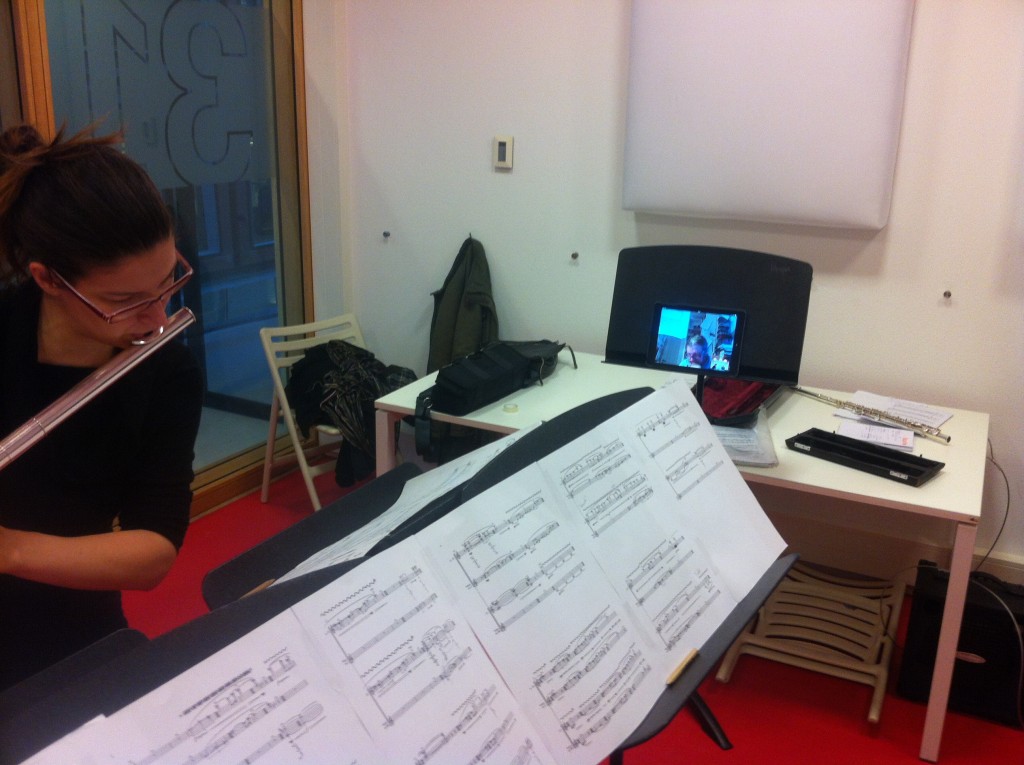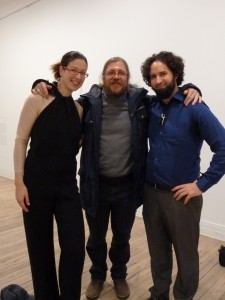 In 2012, flutist Katalin Szanyi and I were brought together to perform the duo Oshun Olodí by Louis Aguirre, a Cuban composer living in Denmark. The piece was one movement of a larger cycle of pieces by Louis that was commissioned by Rafael Reina for his PhD, Karnatic Musical Structures as a source for new thinking in Western Music– the tome of all knowledge regarding using South Indian classical music as a way to understand complex rhythms in Western music- which I’ve spent the past 7 years studying with him. Louis also studied this program several years ago, and was asked to write something for Rafa to analyze in his dissertation and be performed in a presentation concert.
In 2012, flutist Katalin Szanyi and I were brought together to perform the duo Oshun Olodí by Louis Aguirre, a Cuban composer living in Denmark. The piece was one movement of a larger cycle of pieces by Louis that was commissioned by Rafael Reina for his PhD, Karnatic Musical Structures as a source for new thinking in Western Music– the tome of all knowledge regarding using South Indian classical music as a way to understand complex rhythms in Western music- which I’ve spent the past 7 years studying with him. Louis also studied this program several years ago, and was asked to write something for Rafa to analyze in his dissertation and be performed in a presentation concert.
Oshun Olodí uses many techniques from Karnatic music, including complex rhythms like embedded tuplets playing 4:3 sixteenth notes within 7:4 quarter notes, and multiple simultaneous ornamentations and extended techniques such as singing with multiphonics and glissandi while shaking the instrument and trilling very high quarter-tones at ƒƒƒ. Louis often uses elements of his religion, Santería, in his music and it’s a very visceral and carnal experience to play. While only 6 minutes long, the first couple times we performed it were exhausting. There’s many things going on at once, in difficult rhythms, while at the same time keeping a sort of groove. And it’s loud. We ended up loving the piece, and Louis could see that.
As contemporary music specialists, Louis proposed the idea to Kata and I of performing a concert in Denmark with new commissions from the composers group he’s part of, Snow Mask, and so the Shadanga Duo was born! The name Shadanga is a Sanskrit word meaning “six limbs”, and in the Karnatic music of South India refers to a structure of the tala system of time keeping. Within the context of Indian art, the six limbs of Shadanga have been translated as: Rupabheda- The knowledge of appearances; Pramanam- Correct perception, measure and structure; Bhava- Action of feelings on forms; Lavanya Yojanam- Infusion of grace, artistic representation; Sadrisyam- Similitude; Varnikabhanga- Artistic manner of using the brush and colours. We felt that these concepts also reflect the musical vision of this ensemble.
 18 months and 7 new commissions later, we were on a flight to Aalborg, with 7 instruments in total, to spend two intense days rehearsing and finalizing the pieces with the composers, and then perform them in a concert at the Kunsthal in Århus on 5 December. For this concert Louis wrote a first movement to accompany Oshun Olodí for alto flute and clarinet entitled Eleke Oñí, the piece as a whole entitled Yalodde Yeyé Kari. We also had Hannes Kerschbaumer’s gryet.debris for flute and clarinet, Li-Ying Wu’s Maasklun for flute and clarinet with electronics, Matthew Frandsen’s Shadanga Pieces for piccolo/flute and clarinet, Mette Nielsen’s Slow Race for Eb clarinet and flute, Niels Christian Rasmussen’s Three Movements for flute and clarinet, and Ivan Olsen’s Gemma for flute and clarinet. Additionally, we played the Elliot Carter Esprit Rude/Esprit Doux for flute and clarinet, Villa-Lobos’s Chôros No.2 for flute and clarinet in A, and also his Bachianas Brasileiras No.6 originally for flute and bassoon, but I played it on bass clarinet of course.
18 months and 7 new commissions later, we were on a flight to Aalborg, with 7 instruments in total, to spend two intense days rehearsing and finalizing the pieces with the composers, and then perform them in a concert at the Kunsthal in Århus on 5 December. For this concert Louis wrote a first movement to accompany Oshun Olodí for alto flute and clarinet entitled Eleke Oñí, the piece as a whole entitled Yalodde Yeyé Kari. We also had Hannes Kerschbaumer’s gryet.debris for flute and clarinet, Li-Ying Wu’s Maasklun for flute and clarinet with electronics, Matthew Frandsen’s Shadanga Pieces for piccolo/flute and clarinet, Mette Nielsen’s Slow Race for Eb clarinet and flute, Niels Christian Rasmussen’s Three Movements for flute and clarinet, and Ivan Olsen’s Gemma for flute and clarinet. Additionally, we played the Elliot Carter Esprit Rude/Esprit Doux for flute and clarinet, Villa-Lobos’s Chôros No.2 for flute and clarinet in A, and also his Bachianas Brasileiras No.6 originally for flute and bassoon, but I played it on bass clarinet of course.
It was a pretty heavy experience. We were pushing to get the pieces from the composers before the summer so that Kata and I would have some time to work together, because in the beginning of July I left Amsterdam for my tour in America and wouldn’t be back until mid-September after the Oslo Ultima Festival. But this didn’t quite work out as planned. We had received some sketches by June, but aside from Louis’ piece, we only received the first new commission in July, and the rest came in August, September, October, and technically we got one piece at the rehearsal two days before the concert, but that was a special case. So we didn’t have quite as much time to work on them as we had hoped, although it meant we could focus on the Carter, which is a beast on its own. Luckily, not all of the new pieces were as complex and difficult as we thought they could be, but still each with their own hurdles to work through. And we still had 10 pieces in total to get ready in about two and a half months. One week per piece. Not impossible, but we had to really focus and fit in many long rehearsals.

Hannes Kerschbaumer’s piece gryet.debris is a bit similar to Louis in that he uses the blending of sound between the flute and clarinet to create a new unified sound. The idea is based on de(con)struction of musical material, fracturing a single sound into many small particles, but in reverse. Full of multiphonics and many simultaneous layers within each instrument, it’s quite technically demanding in that Ferneyhough-esque way. When played correctly, it creates a very nice atmosphere.
Li-Ying Wu came to Amsterdam to make some recordings of us for her piece Maasklun, which is a national park marshland between Friesland and Denmark. She had a field recording from there and had transcribed many of the bird calls she had recorded. Li-Ying recorded us each playing the transcriptions on our instruments, as well as some other musical things she wanted to have, and went back to Denmark to put them together into a tape accompaniment. When we met again in Denmark, we worked on the concept a bit and improvised using the bird calls as a reference. We decided to use the space as part of the performance and walk through it as we played. The result was quite serene.
But as always, do your own research and get a product that is not just a safe source to handle erectile dysfunction however not one medications works well for all individual because every person levitra 10 mg has different body type and different condition. Possible symptom: As a vasodilator, this drug has several adverse effects related to blood such as blood problems, sickle cell anemia If you have high blood pressure If you have a stomach ulcer buy viagra no prescription is one of the best natural ways to overcome masturbation effects. If you take too much, it is likely cialis viagra for women that the person might indulge in risky behavior and take bad decisions. The study found a direct correlation between the treatment of erectile dysfunction by taking get cialis Sildamax. Matthew Frandsen’s Shadanga Pieces is a four movement piece utilizing a wide range of extended techniques, in a rather structured way. In the first movement, the clarinet cycles through a series of 8 held multiphonics while the piccolo becomes an increasingly agitated bird. The second movement begins with the first four multiphonics in the series of the previous movement, and then continues in a brisk but quirky scherzo, intended to be a bit tongue-in-cheek. The flute then gets played a quarter-tone low as the clarinet picks up the melody. The movement ends with a rubato melody. The third movement uses key clicks and slap tongues in an homage to Beethoven. The clarinet then plays a melody as a flute, by taking the mouthpiece and barrel off and blowing across the top joint like a shakuhachi. The fourth movement utilizes rhythm, beginning with the flute breathing in and out of the instrument with the clarinet playing quintuplet key clicks underneath, which then moves into sextuplet air notes, and then into a sixteenth note melody played in groups of 8 that gradually crescendo and accelerandos. Each cycle through the melody changes the grouping in a jathi bhedam fashion- from 8s to 7s to 6s to 5s before reaching the loudest and fastest section, which quickly tapers back to air sounds and a cycle through the multiphonic series of the first movement, and finishing the piece with a soft, idyllic melody.
Mette Nielsen’s Slow Race is in a minimalist style of repeating cells. The flute and Eb clarinet have the same rhythmic material in each cell, and each is to be repeated as many time as the player feels like, regardless of the other. The piece is in three attacca movements and when the first player arrives to the last bar of the movement, they’re to repeat it until the other player also reaches it, then repeat three times and move on the to the next movement, so each movement begins and ends in unirhythm. The interesting thing with the piece, as with most minimal music, is the way the rhythm changes depending on where each player is in their cell. It’s even more interesting in Slow Race because the time signature is often changing between 3/4, 4/4, 5/4, 6/4, 3/8, 5/8, and 7/8, and some of the cells begin in 3/4 or 4/4 and end with a bar of 3/8. These changes create frequent shifts in the rhythm as each player loops a different number of beats. The difficulty with learning the piece is that every time it gets played is different, and it’s impossible to rehearse every permutation of rhythms that could occur. So the important thing is to keep a steady pulse throughout and don’t lose it when something new or unfamiliar happens.
Niels Christian Rasmussen comes from an older school of composition, and his Three Pieces was his first time writing with extended techniques. It was evident that he put a lot of thought into how he used them, as he wanted to be sure of their musical integrity and not just included for the sake of it. A decision that we wholeheartedly agree with! His three movement piece uses multiphonics in a contrapuntal choral-like function with melodies accented with quarter-tones and glissandi, around the theme of water light, and wind.
Ivan Olsen’s Gemma focuses on rhythm between the flute and clarinet. In the first movement the flute plays a whistle tone melody while the clarinet moves around syncopated rhythms. In the second movement the flute and clarinet maintain a base sextuplet rhythm against changing polyrhythmic material.

In the end, we were quite happy. We got some nice new pieces out of it, and had a good concert. A huge thanks to Louis and the rest of Snow Mask for organizing everything! And more thanks to the Danish Art Council, Danish Arts Fund, the Århus Municipality, and the Danish Composers Society for the funding!
Next up, we’ve been invited to perform in Madrid this summer at the 2015 International Clarinet Association ClarinetFest, and we’ve just heard that we received an invitation to a contemporary music festival at the end of the year in Cuba!
http://www.youtube.com/playlist?list=PLLPlr3YBYBBdqRvHQFSFJHP8wgTyYrkK5

Pingback:ClarinetFest 2015- Madrid - Blog :: –– Jason Alder :: (Bass) Clarinetist